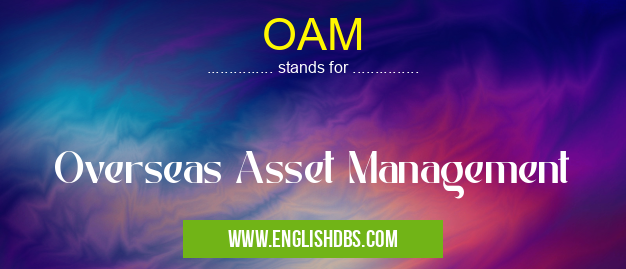What does OAM mean in MANAGEMENT
Overseas Asset Management (OAM) is a term used in the financial industry to describe the management of assets that are located outside of the investor's home country. OAM is often used by investors who are looking to diversify their portfolios and reduce risk. By investing in assets in different countries, investors can reduce their exposure to any one particular country's economy or political environment.

OAM meaning in Management in Business
OAM mostly used in an acronym Management in Category Business that means Overseas Asset Management
Shorthand: OAM,
Full Form: Overseas Asset Management
For more information of "Overseas Asset Management", see the section below.
» Business » Management
How Does OAM Work?
OAM is typically conducted through a fund or investment vehicle that is domiciled in a country other than the investor's home country. The fund will invest in a variety of assets, such as stocks, bonds, and real estate, in different countries around the world. Investors can then purchase shares in the fund and gain exposure to the underlying assets.
Benefits of OAM
There are a number of benefits to investing in OAM, including:
- Diversification: OAM can help investors to diversify their portfolios and reduce risk. By investing in assets in different countries, investors can reduce their exposure to any one particular country's economy or political environment.
- Growth: OAM can potentially provide investors with growth opportunities. By investing in emerging markets or other countries with high growth potential, investors can potentially earn higher returns than they would by investing in their home country.
- Tax benefits: OAM can sometimes provide investors with tax benefits. For example, some countries offer tax incentives for investors who invest in their country's assets.
Risks of OAM
There are also some risks associated with investing in OAM, including:
- Currency risk: OAM investments are exposed to currency risk, which is the risk that the value of the investment will fluctuate due to changes in the exchange rate.
- Political risk: OAM investments are exposed to political risk, which is the risk that the government of the country where the investment is located will take actions that could adversely affect the value of the investment.
- Liquidity risk: OAM investments may be less liquid than investments in the investor's home country. This means that it may be more difficult to sell the investment quickly if needed.
Essential Questions and Answers on Overseas Asset Management in "BUSINESS»MANAGEMENT"
What is Overseas Asset Management (OAM)?
Overseas Asset Management (OAM) refers to the management of financial assets located outside of an investor's home country. It involves investing in international stocks, bonds, real estate, and other financial instruments. OAM can provide diversification, access to global markets, and potential for higher returns.
Why consider Overseas Asset Management?
There are several reasons to consider OAM:
- Diversification: OAM can help diversify your portfolio by investing in assets that are not correlated to domestic markets. This can reduce overall risk and enhance returns.
- Global Market Access: OAM provides access to a broader range of investment opportunities, including emerging markets and sectors that may not be available domestically.
- Potential for Higher Returns: International markets often have different economic cycles and growth rates compared to domestic markets, which can lead to potential for higher returns.
How does OAM work?
OAM typically involves working with a financial advisor or investment firm that specializes in international investments. They will assess your investment goals, risk tolerance, and time horizon, and recommend a suitable OAM strategy. This may include investing in foreign stocks, bonds, or a combination of both.
What are the risks associated with OAM?
OAM carries certain risks, including:
- Currency Risk: Fluctuations in exchange rates can impact the value of investments in foreign currencies.
- Political Risk: Political instability or changes in government policies can affect the performance of investments in specific countries.
- Economic Risk: Economic conditions in foreign countries can impact the performance of investments there.
How to get started with OAM?
To get started with OAM, consider the following steps:
- Consult with a financial advisor: Seek professional guidance from a qualified financial advisor who specializes in OAM.
- Determine your investment goals: Clearly define your investment objectives, risk tolerance, and time horizon.
- Research international markets: Explore different international markets and their potential for growth and returns.
- Diversify your portfolio: Invest in a variety of international assets to reduce risk and enhance returns.
Final Words: OAM can be a valuable tool for investors who are looking to diversify their portfolios, reduce risk, or gain exposure to growth opportunities. However, it is important to be aware of the risks associated with OAM before investing.
OAM also stands for: |
|
| All stands for OAM |
